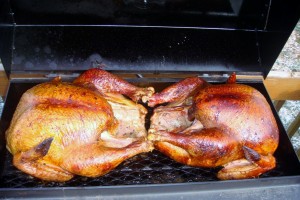The Science of Smoking Turkey
Have you ever cooked a perfect turkey? Were the breasts moist and tender and the leg completely cooked? Chances are, not always. Why is it so hard to get the dark meat cooked perfectly without over cooking the white meat? The reason is that a turkey is actually two distinctly different kinds of meat. The breast meat is very different from the leg, thigh and wing meat. This can create a real challenge when it comes to cooking the perfect bird.
The make-up of a turkey:
At the biochemical level a turkey is a combination of approximately 3 parts water to one part fat and one part protein. The majority of meat comes from muscle fibers in the turkey, which are mostly proteins – notably myosin and actin. Because turkeys rarely fly but rather walk, they contain far more fat in their legs than in their breast, which results in the strong differences in texture between these sections of the bird – and the difficulty in making sure that all portions of the bird are properly heated.
The science of cooking a turkey:
As you cook the turkey, muscle fibers contract until they begin to break up at around 165 degrees Fahrenheit. Bonds within the molecules begin to break down, causing proteins to unravel, and the dense muscle meat to become tenderer. Collagen in the bird (one of three protein fibers that attach muscles to the bone) breaks down into softer gelatin molecules as it unwinds. The dryness of a turkey is a result of muscle proteins coagulating within the meat, which can result if it is cooked too long.
Temperature differentials in cooking a turkey:
Part of the problem, as described above, is that the different nature of the light and dark meat in a turkey results in different rates to reach the coagulation of the muscle proteins. If you cook it too long, the breast meat has coagulated; if you don’t cook the bird long enough, the dark meat is still tough and chewy.
Harold McGee, a food science writer, indicates aiming for 155 – 160 degrees Fahrenheit in the breast), but you want 180 degrees or above in the leg.
White Turkey Meat
- White meat is found in the breast and wing muscles of a turkey.
- Turkey can fly, but it is not their main mode of locomotion. Turkeys use their wing muscles when they need a burst of speed to escape predators. These muscles produce a lot of power, but they fatigue quickly.
- Turkey breast and wing muscles consist mainly of white muscle fibers. These fibers contract quickly and split ATP at a fast pace, though they become exhausted quickly, too.
- White fibers are powered by anaerobic respiration so a turkey can move quickly even though its muscles may have exhausted the available oxygen. The tissue contains a large amount of glycogen, which can be used as fast energy source.
Dark Turkey Meat
- Turkey legs and thighs are dark meat.
- Turkey spends a lot of time walking on the ground. Their leg muscles are adapted for regular, continuous use.
- Leg and thigh muscles consist primarily of red muscle fibers. These fibers contract slowly and split ATP for energy at a relatively low rate.
- Red muscle fibers rely on aerobic respiration. The protein uses oxygen to relax/contract so this tissue is rich in capillaries, which give it a deep color and rich flavor. Dark meat contains a lot of myoglobin and is rich in mitochondria, which produce energy for the muscle tissue.
NOV

